Black Jack Adair, Donegal’s Most Hated Man
John George “Jack” Adair was born on the 3rd March 1823 in “Queen’s County” in Ireland. (The county in question was renamed “Laois” after Irish independence, for obvious reasons.) It was an appropriate home for the Adairs, who were all highly loyal servants of the crown. The family had been landholders in Ireland since the 16th century, and Jack’s ancestor Robert Adair had been knighted by King William for raising and leading a regiment at the Battle of the Boyne. One of Jack’s cousins was a baronet and MP, and Jack’s parents had grand plans for him. He was educated at Trinity College in Dublin, after which he received a post in the British diplomatic service.
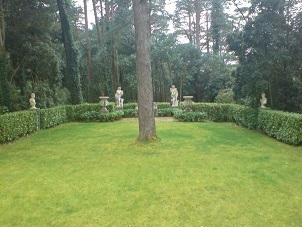
Jack was posted to Florence, where he developed a love for the Italian architecture and design that would influence him later in life. That wasn’t all he developed, however. A British banker living in the city named John Leland Maquay took young Jack under his wing, and there is strong evidence to suggest that Jack repaid him by sleeping with his wife and (unknown to the banker) conceiving a child with her. Despite this (or perhaps because of it) he retained a close link with Maquay and his family, a financial connection that proved to be very useful when he abandoned the diplomatic service. It proved an ill-fit for his undiplomatic temper and tendency to speak his mind. So he headed to America to make his fortune.
Some sources suggest that Jack may have spent some time in the military after he left diplomacy, though it’s hard to imagine it suited him any better. They claim that he reached the rank of captain, though if he did he didn’t use it in later life. Still, it’s not hard to imagine the hot-tempered Adair managing to get himself discharged. Regardless, he headed to new York some time in the 1850s where he found one thing he was indisputably good at – land speculation. His family had money (his father had inherited sugar plantations in the West Indies, for example) and Jack proved to be very good at taking money and using it to make more money. Flush with this cash he headed back to Ireland, where he set up a new branch of his land brokers and started buying up land in Donegal. He combined several smaller holdings to create a single large estate. It was named Glenveagh after the local name for the general area, which translates as “glen of the birches”. It was here, in 1861, that he would shroud his name in infamy with what became known as the Derryveagh evictions.
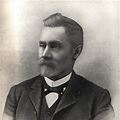
The exact reasons for why Adair ordered the evictions are somewhat disputed. One story has it that it was simply to “improve the view from his castle” – this is somewhat undermined by the fact that the castle would not be built until ten years later. In fact, at this time Adair’s seat on the estate was Glenveagh Cottage, which would become the residence of the estate’s stewards after the castle was completed. Another story has it that Adair took umbrage with his tenants after they reported him for trespass when he hunted across their lands – while it is possible that they did so, it is definite that relations between the two groups were frosty prior to that. The truth was that Adair had a vision for his estate, and tenants formed no part of it. Instead he saw the future of the estate as being in hunting and sheepfarming.
In fact Jack had already employed two men to move the sheep onto the estate, named Rankin and Murray. Murray was a Scot, and frequently argued with the tenant farmers. In November 1860 he went missing, and a few days later his dead body was found at the bottom of a gorge. It was indisputably murder, with signs of a vicious struggle on his body and on the ground above, but the police were never able to find a suspect. Some locals thought that the murder was carried out by Rankin on Adair’s orders, [1] while others claimed that Rankin was having an affair with Murray’s wife and that he moved into her bed on Murray’s death. This seems unlikely, especially since she was pregnant at the time. In fact, after the child was born she returned to Scotland. The police thought it more likely that he was killed by the tenants, and Rankin was placed under police protection. A series of letters survive where the constables complain of the poor treatment they received from Adair, who was at the time a Justice of the Peace for the area.
I spoke to Mr Adair on the 20th instant [2] to provide us with fuel and light, which he declined to give us. He has also refused to allow us to cut timber. [We] have to patrol the mountains during the day, and return at night to a damp cold house, with our clothing wet, ourselves fatigued from cold and want of food, having no fire to cook our victuals or dry our clothing.
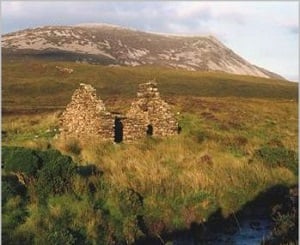
Whether it was the murder of Murray which prompted it, or if it had been his plan all along (inspired by similar “clearances” in Scotland), on St Patrick’s Day (17th March) 1861 Adair obtained a writ of Habere facias possessionem. This was a legal document granting him the right to evict his tenants and take back possession of his land. With this in hand, he gathered a group of two hundred and three police officers along with ten “crowbar men”, and sent them off to execute it. The first house they came to belonged to a widow named McAward, and there with the weight of the law behind him, the sheriff executed the writ. By law, the widow and her seven children were evicted from the house, and with them out the crowbar men made short work of demolishing it. The posse went from house to house, forty six in all, and of those 28 were levelled or otherwise made uninhabitable to prevent the tenants from remaining.
244 people were left homeless, 47 families including 159 children. In the end, forty two of the residents wound up in the workhouse, the last resort of the poor and penniless, while over half would emigrate to Australia. Their fares were paid by the Donegal Relief Committee, a charity organised in Sydney by a Donegal migrant named Michael O’Grady. This charity also bought land for them in Australia, and also helped 130 people from poverty-stricken Gweedore join them on the trip to this new land of opportunity. Behind them was the scene of one of the most infamous evictions in Irish history, one which made the name of “Black Jack” Adair forever a curse in the county of Donegal.
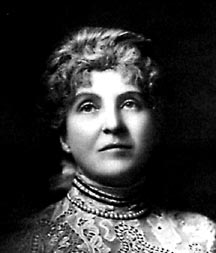
It was while she was organising the education of her children in Europe that Cornelia Ritchie first met Jack Adair. She was a mild-mannered widow of 32 with two children from her first marriage, while he was a fiery bachelor of 46. Still, the two hit it off, and in 1869 the two were married. At first the two split their time between Ireland and New York, where Cornelia had family, but Jack disliked the city, and the feeling was apparently mutual. Cornelia’s relatives, having heard stories of the wild American frontier, suggested to her that the two might be happier out west. So Jack and Cornelia Adair set out to establish a brokerage office for his firm in Denver, Colorado.
While there, he went out on a hunting trip with a local celebrity as a guide. He was a former confederate Colonel named Charles Goodnight, who ten years previously had been involved in the famous “gather” of feral cattle that had been living wild across Texas during the civil war, taking the herd north to Colorado along what became known as the Goodnight-Loving trail (Oliver Loving being the other leader of the drive). He had then formed a partnership with cattle baron John Chisum, taking his herds to Colorado to sell to the army. The hunting trip was a disaster (allegedly the only thing Jack killed was his own horse when he dropped his rifle) but Colonel Goodnight found what he’d been hunting – a partner.
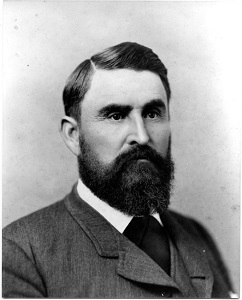
The railway was expanding, and Goodnight could clearly see that the days of the great cattle drives were coming to an end. He had founded the first cattle ranch on the southern plains of Texas, and he proposed to Adair that he provide the capital for Goodnight to expand it out into the unclaimed area known as the Texas Panhandle. Adair was wary however, and refused to buy land he had not seen – and so the two men, along with their intrepid wives, a group of cowboys and “ranching supplies” (including several fertile bulls for breeding purposes) set out for Palo Duro Canyon.
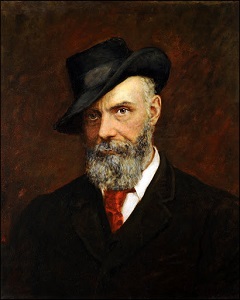
The trip took twelve days, and was not without adventure. A local group of outlaws heard of the Adairs and decided to kidnap them to hold for ransom, even going so far as so build a hideout to hold them. Fortunately, Goodnight heard rumours of what they were up to and persuaded a group of US cavalry to act as an escort. Adair’s temperament, meanwhile, rubbed several of the cowboys the wrong way – on one occasion when he demanded a horse be saddled for him, the cowboys took care to give him the meanest horse they had, and were then disgusted when under Adair’s hands it became “the gentlest horse in the world”. In fact, it was only through Goodnight’s intervention that Adair did not get attacked by the cowboys, and he would later comment that he sometimes regretted not fighting Adair himself.
If Adair was rubbing people the wrong way, Cornelia was blossoming. She rode the entire distance from Colorado to the ranch, and she was the one who picked out the site for the ranch house. It was her rather than Jack who would be regarded as the true founder of the JA ranch, as she was the one who wound up running it for the rest of her life. Still, it was Jack and Goodnight who made the deal – Adair to provide two thirds of the capital and own two thirds of the ranch, and Goodnight to make up and own the remainder. In addition they agreed that Goodnight would manage the ranch with an annual salary of $2,500, and that Adair would lend him the shortfall in what he needed to make up his share of the investment at 10% interest. It was a good deal for Adair – fifteen years later he had made a profit of $512,000 over his original investment. With that settled then, he returned to Ireland to build his castle in the glen.
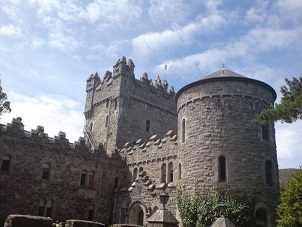
Jack Adair did not lack ambition when he built Glenveagh Castle. His reported inspiration was Balmoral Castle, the famed Scottish retreat of the British royal family, and he intended to out-do it. He planted palatial gardens around it, some in Italian style (inspired by his beloved Florence), some in French styles and all with a view of the glen. He decorated it with sculpture both new and old, including sphinxes, figures of Greek gods, busts in the Tunisian style and even two temple guardians taken from distant Bali. The castle itself boasted a grandiose exterior, but a thoroughly modern interior. With the caste complete Jack turned his attention to the estate, but he would never get it to the level of hunting he desired.
“Black Jack” remained a hated figure in Donegal, and in 1884 the Edinburgh naturalist James Sconce reported that a woman from a family he had visited in Gartan had been overheard bargaining with a man to take her out to Tory Island where there was:
…a stone which, if it could be turned, and the name of Mr Adair repeated over it, would have been sure to bring about his death within a year.
The woman was said to have died before she could make the trip, but perhaps someone made it in her honour. For the following year in 1885, while on one of his frequent trips to America, Jack Adair died aged 62 years old. His body was returned to Ireland for burial in the soil of Glenveagh. The locals gave their opinion of this by throwing a dead dog into his grave the night before his burial. Cornelia memorialized him by inscribing “Brave, Just and Generous” on a rock by the side of the lake, but a few years later the rock was destroyed and fell into the lake below. The official cause was lightning.

Cornelia inherited her husband’s estate, [3] and she seems to have had a much better relationship with the locals. She spent most of her time in America, though, buying out Colonel Goodnight’s share of the JA and being much more hands on in running it than Jack had been. She died in 1921, and was much more widely mourned than he had been. Glenveagh Castle went on to be the site of the mysterious disappearance of Professor Arthur Kingsley Porter [4] before being bought by Henry Plumer McIlhenney, the Tabasco Sauce millionaire. He made it a retreat for Hollywood actors and other celebrities to get away from the attentions of the press. [5] On his death he gave the castle and estate as a gift to the nation, and it’s now one of Ireland’s largest National Parks – a monument to those evicted from Derryveagh, and a lasting testament to the dark memory of “Black Jack” Adair.
Pictures of Glenveagh taken by the author. Other images via wikimedia except where stated.
[1] Or by Adair’s possible son William Maquay, or by another illegitimate son entirely, or by “Black Jack” Adair himself.
[2] An archaic usage meaning here “of the current month”
[3] A clause in his will stated that if she had predeceased him then the estate would go to William Maquay rather than to her children, fuelling the “illegitimate son” rumours.
[4] For more details on the later history of the castle, see here.
[5] McIlhenney himself was discreetly homosexual, and so appreciated a quiet getaway location.
